| 1 | One of 5 flying snake species |
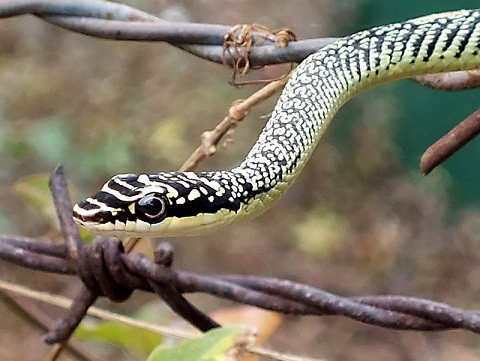
In the exotic forests of Asia, in the green humid forests crawling with lizards and strange insects, there exists the ultimate nightmare of the ophiophobe. It isn’t a giant basilisk measuring 40 metres, or a pitviper which can spit swarms of venomous wasps at people. No, it’s a snake which can fly, an unspeakable fluke of nature which simply should not exist, similarly to a flying ant or flying squirrel.
There are 5 species of flying snake worldwide, and the largest and best-researched is easily the golden tree snake (Chyrsopelea ornata). This snake inhabits a wide range in south-east Asia, including India, the whole of Thailand, western Malaysia, Laos, Cambodia, Vietnam, and Bangladesh. They’re particularly abundant in Thailand, where it’s said that in traditional villages, a golden tree snake is nearly guaranteed to be in the vicinity at all times.
The golden tree snake has a green-black colour, and is mildly venomous, but not dangerous to humans. It’s neither too big nor too small, reaching a maximum length of 140cm, with hatchlings averaging at 11-15cm long.
Their heartlands are forests, but they’re comfortable anywhere with trees, including isolated tree clumps near farmland, or even in towns. Golden tree snakes can also be found in caves on occasion, waiting to ambush bats.
| 2 | Spine-shifting flight adaptions |
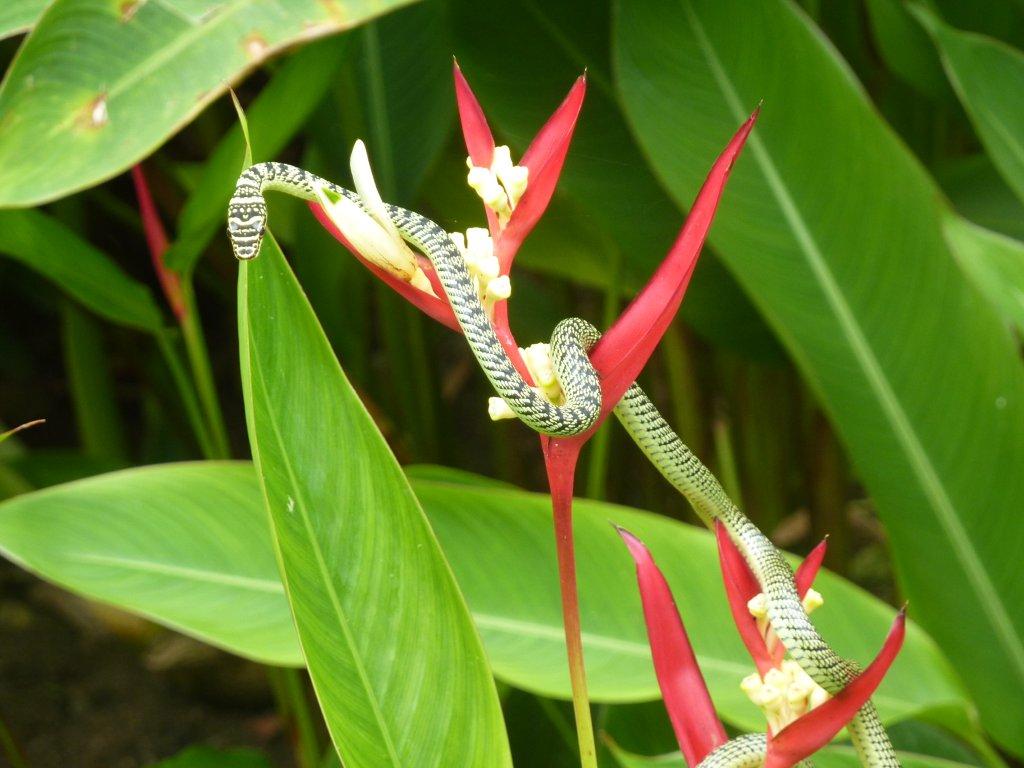
Technically, the golden tree snake doesn’t fly. It actually glides. This isn’t a freaky winged serpent, and it’s incapable of gaining height. Its strategy is to fly from tree to tree, or to leap from a branch and glide to the ground at a breakneck pace, sometimes in pursuit of a watchful gecko.
The strategies for flying were barely known until recently, but all members of the Chrysopelea family change their body dramatically to become more aerodynamic. If you view the snake’s tube shape as a circle, then the snake will extend its ribs, and instead become an upside down U-shape, which captures air in the cavity beneath. Extending its ribs totally changes its body shape, without ripping itself apart in the process.
Once in mid-air, the golden flying snake immediately begins writhing in an S-shaped motion. It raises and wiggles its tail constantly, allowing it to direct itself as it glides forward. The landing is clumsy, but snake rarely strops, slithering away instantly in an unbroken charge.
| 3 | Doesn’t fly the furthest |
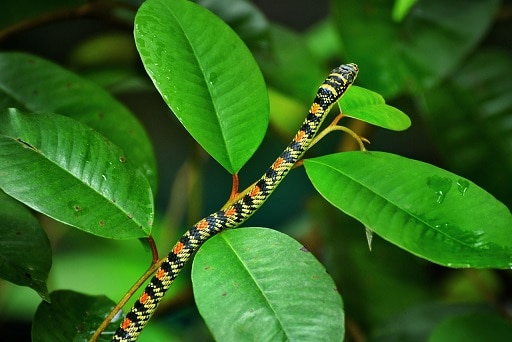
The golden tree snake takes some time to prepare before gliding, as transitioning to the upside-down U-shape takes 10-35 seconds. There’s only one downside, as the altered body shape probably compresses the lungs, meaning that they can’t breathe while gliding. The only body part which doesn’t flatten out is the tail.
The golden flying snake has been seen travelling 100 metres in the air before. However, being the largest flying snake comes with a downside, as weight is an immovable force which no amount of scale-shifting tricks can fully overcome. A study from 2011 analysed its much rarer cousin the paradise flying snake, and found a substantially higher horizontal to vertical distance ratio of 4.2. Its line of flight was flatter, meaning that it glided far further.
The golden flying snake had a ratio of just below 1. For example, this author witnessed one leap from a tree 6 to 7 metres high, and hit the ground 5 to 6 metres away.
That being said, the boa constrictor is probably still quite jealous of the golden tree snake.
| 4 | Climbs vertical trunks with ease |
Before it leaps into a majestic glide, the golden tree snake has to ascend its tree in the first place. This species is one of the ultimate tree-climbers of the snake kingdom, more than matching the American corn snake. Its belly is covered with strongly keeled (rough) scales, allowing them to dig securely into a tree’s bark-covered trunk. Their climbing exploits seem to defy gravity, ascending fully vertical trunks with no obvious purchase.
Once in their treetop perch, the golden tree snake can slither along the thinnest branches imaginable. They can leap from suspended twigs that barely seem to support their weight, like the snake equivalent of a tightrope walker. They can also land on these incredibly thin branches when leaping from tree to tree, instantly coiling their bodies around them. The same skills help them to climb up walls and lampposts when they invade towns and cities.
According to this informal survey, the golden tree snake is the most commonly sighted Thai snake from day to day.
| 5 | Fast and twitchy, impatient |
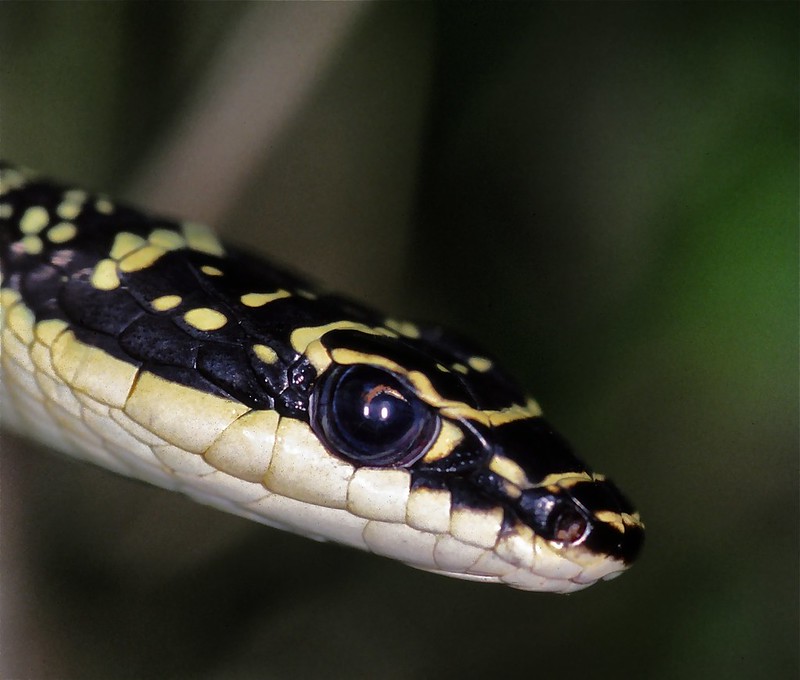
The golden tree snake usually allows people to come very close, even to within 1 metre without flinching. But when it does finally get spooked, this snake can flee incredibly quickly, usually vanishing up a tree. This is a particularly fast species, and according to herpetologists, catching one is almost impossible. The nearby Russell’s viper is so lazy that it sometimes allows farmers to step on its tail.
This twitchy speed probably evolved for hunting, to help it pounce on prey from trees. The golden tree snake is an active forager rather than an ambush predator, and high branches are the perfect vantage point for scanning the landscape. It strategy is to spot a gecko or lizard, and slither towards it slowly rather than charge. It keeps slithering patiently, until 30cm away, the golden tree snake suddenly pounces. Its smaller prey is eaten alive, but with larger reptiles, Chrysopelea ornata usually wraps around a coil and repeatedly bites them, to unload multiple small doses of venom. Occasionally, it’ll break its prey’s neck with a strong crushing bite.
| 6 | Favourite prey: Tokay gecko |
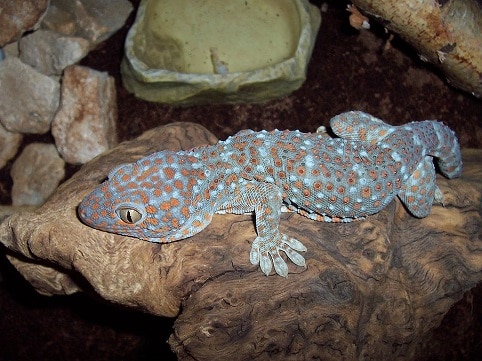
The golden tree snake’s diet includes bats, certain rodents, and nesting birds. However, their signature foodstuff is undoubtedly the Tokay gecko, one of the biggest species in the world.
This gecko doesn’t look appetising in the slightest. It looks like a leathery old shoe, dusty blue with multiple brown patches and a thick, cylindrical body. But for golden tree snakes, this is the single species they’ve been observed eating the most.
It’s no easy task, as Tokay geckos use the crafty strategy of shedding their own tail, which writhes and twitches for 45 minutes in order to fool the predator. They then regrow their tail over the course of 3 weeks, ready for another session of deception.
The Tokay gecko is an excellent climber itself, exerting a grip force of 450 pounds, using fine filaments called satae on its feet. Tokay gecko’s have a viciously strong bite, and biologists have observed 2-3 hour duels between them before, sometimes with the snake fleeing first. Meanwhile, golden tree snakes are hunted themselves by blue kraits.
| 7 | Commonly found in roofs |
The golden tree snake isn’t shy about straying into human habitations. They’re common beneath old piles of wood in the garden, and they often slither up walls vertically and stash themselves in thatched roofs, where they wait for bats roosting in darkness. In 1915, it was estimated that 80% of snakes invading Thai households were golden tree snakes.
Even today, golden tree snakes often descend to cool bathrooms during the hot part of the day, forcing local Thai people to shoo them away on a trip to the toilet. Unfortunately, this leads to many being killed, after residents whack them to death, mistaking them for deadlier snakes.
In 2008, a hotel owner in Malpe, southwest India was stunned when he found a golden tree snake hiding in a vegetable basket. The species hadn’t been seen in the town for several years. Experts theorised that the flying snake had leapt from a tree, as the vegetable truck drove through the forested Western Ghats mountain range, before accidentally travelling dozens of miles.
| 8 | Unusual colour morphs |
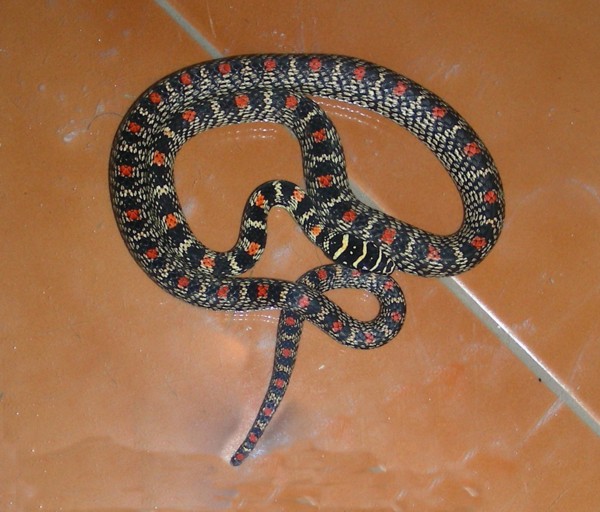
In most of its range, from Vietnam to Indonesia, the golden tree snake is mainly a green and black snake. It has a rich green base, interspersed with small black stripes, with a thin black line piercing the centre point of each scale. It has round black pupils rather than vertical, and a cream-coloured underbelly, with green tinges and no obvious stripes. This is by far the most common type, but further west, in Sri Lanka and south-west India, there’s a freakish morph which Thai people probably wouldn’t recognise.
With this version, the green base remains, but is barely visible, as the black stripes are far thicker. The head is particularly black, and more noticeably, each scale is patterned with a red mark. These are shaped like a three-petalled flower, and can be orange as well as red.
The eastern boundary for this blacker version is reportedly the Goa mountains of India. The further east and south you travel, the more the red markings decrease, until they vanish altogether.
| 9 | No recorded human deaths |
The golden tree snake boasts the skill of flying, but its venom is nothing special. Its bite feels like a mere pin prick, and while the venom is strong enough to wipe out small rodents, the species regularly has to bite the prey in its clutches multiple times. No human deaths have ever been recorded. In adults, the venom is too weak to cause even nausea or muscle weakness, let alone death.
That said, nothing can be ruled out. There’s always a chance of an unusually venomous subpopulation, like in south-east France, where there’s a rare neurotoxic enclave of asp vipers.
The golden tree snake also has special UV resistant lenses in its eye, a feature shared with the Montpellier snake of France. Scientists have discovered a particular reliance on visuals for hunting, unlike the Sahara horned viper, which senses vibrations in the desert sands. The golden tree snake needs a keen pair of eyes for scanning the swaying treetops for motionless lizards, and identifying the most strategic branches to fly towards.
| 10 | Crazy Thai folk legends |
In rural Thailand, there are many rumours and myths surrounding this airborne snake. The first is simply that the bite is a death sentence, and will flood your body with deadly toxins. In the 1990s, snake expert Joachim Bulian was bitten several times while studying golden tree snakes up close. He described how the local villagers watched over him with extreme fear, and were shocked and relieved when he showed no symptoms several hours later.
Another Thai belief is that the species sometimes slithers inside the open mouth of its main prey, the Tokay gecko. Once inside, it greedily gobbles up the parasites in its stomach, and even devours its liver. Somehow, the gecko politely keeps its mouth wide open the whole time, after which the snake reverses out backwards and leaves.
Bulian doubted the legend, but in his travels, he noticed how the Tokay geckos did keep their mouths wide open when a golden tree snake approached, exactly as the locals described it. This was said to be a form of defensive posture. Unfortunately, he strayed too close, and spooked both animals away before anything magical could happen.
